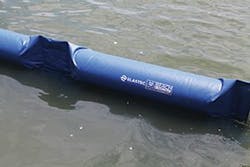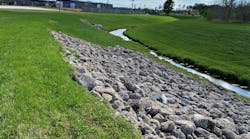Damming for Charity
For the last 37 years, the small town of DePue, IL, has been home to the DePue Men’s Club, a nonprofit organization focused on community leadership. With emphasis on helping local charitable organizations, the club is widely recognized for donating and sponsoring local events in DePue and surrounding cities in the Illinois Valley area.
The small town located southwest of Chicago is also known for beautiful Lake DePue, home of the annual Lake DePue National Championship Boat Races. Club publicity director Eric Bryant says the race draws boating entrants and spectators from around the world. Bryant, who is also the village mayor, explains that the entrance fees and concession earnings from the event help organizations from sports teams to schools to churches and other community organizations.
“If we can help them in any way, then we will,” says Bryant. But, he notes, the lake also has its problems.
The once-pristine waters of Lake DePue were known for fishing and ice harvesting in the 19th century, but they suffered misuse as commerce and industry grew, bringing pollution to the area. DePue village was soon a heavily industrialized area, supplying commodities to the automotive, appliance, and paint industries and using the oxbow-shaped Lake DePue as a disposal site.
The contaminants to the soil and water from these smelting, fertilizer, and paint factories left a significant legacy of toxic heavy metals at such levels that the scenic town is currently a Superfund site. All industry has since left the area, and cleanup is one of the major initiatives for the club and the village. Bryant, who has been instrumental in keeping pressure on to pursue the cleanup efforts—“a frustrating and time-consuming uphill battle”—says that testing has shown high levels of zinc, lead, arsenic, cadmium, cyanide, and chromium. In addition, a slag pile of more than 500,000 tons of contaminant byproducts from the former factories sits in the center of the village. Despite endless bouts of legal and political dialogue, it remains unremediated, and delays from previous landowner corporations continue to plague progress.
After more than two decades in this fight to remove toxins, Bryant is very concerned at his residents’ exposure. “It’s very worrisome when you have children playing in the yards, in the ballparks, and being exposed.”
Nonetheless, Bryant says the lake and the boat races are a huge attraction. The three-day event is held every year during the last week in July.
“We draw about 25,000 to 30,000 people to the area, and when you consider the village itself is less than 2,000 people, this is a huge gathering. Our fans love this event, and it brings a lot of attention to the area and helps emphasize the need to get this cleaned up. And we raise money to support our local organizations as well.”
However, he adds, the lake is very shallow, and it’s a nail-biter as to whether the race can be held when the area experiences summer drought conditions.
“We actually lost the races for about 10 years as silting filled it in, but then in 1982 a state representative got money to dredge the racecourse to give us the required four-foot channel for the high-powered boats, so we could start racing again,” he says. By 1983, he says, the DePue Men’s Club took over management of the event.
But coping with the lake’s water level each year is a constant source of anxiety. The lake is connected to the Illinois River as its water source, and the narrow neck of that connection, about 175 feet wide, is Bryant’s focal point pre-race.
Because a large portion of the lake is silted in, the racecourse depends on the area receiving enough rain to bring the course up to the required level. Bryant says that away from the racecourse channel, the water is generally less than a foot deep.
Bryant and the race committee have put in a request for a permanent dam, which is yet to be built; however, the Illinois Department of Natural Resources installed an inflatable dam in 2013, which allowed the race to take place in what, at the time, was a very dry spell.
“Legally, we can’t do anything until July 1, so we are at the mercy of Mother Nature to keep our water levels up. Even if the water is high in the middle of the month, we’ve seen it drop two weeks before the race. At one point we trapped water, and another time we used sandbags at the channel and pumped in water, but it’s nerve-wracking, to say the least.”
Now, however, Bryant has seen a solution from Dam-It Dams that solves the problem and ensures this important economic revenue stream can continue. The company makes a patented cofferdam system—typically used to dewater a work site, but in this case, it was employed to keep water in.
Jack Nichols, founder and president of the Grand Blanc, MI, company, says that he launched Dam-It Dams in 2000 “after 30 years in the construction business.”
He says, “I realized firsthand there was a need for a fast and effective way to manage water that wouldn’t break the bank, and that would also be environmentally friendly.”
Nichols explains that the company’s products “are made with a geotextile material that is puncture resistant and sturdy enough to withstand rising water levels, and because the material is lightweight, it is portable and able to be stored away for future use.” This was definitely an attribute that appealed to Bryant as a solution to temporarily maintaining the boat racecourse water levels.
The company is one of the few manufacturers that not only makes the product, but ships and installs as well. For emergency solutions such as a temporary diversion of floodwater, or for construction projects on bridges where damming is used to dewater the site, Nichols says, portable cofferdams are a cost-effective solution.
The company’s motto is “Water causing you a problem? Just add water!” The water-filled cofferdams can be linked to form any length of barrier.
As the inner tubes fill, the water pressure builds, forming a strong, stable, cylindrical barrier. The dam unrolls in a controlled and steady manner to create the cofferdam and provide an even and gradual build to make it more secure.
“This method offers a superior barrier when compared to sandbags, which are often ill-equipped to handle large amounts of water, or flood walls that, while they may create a long-term barrier, alter the aesthetic of a home or business from its original intended appearance,” says Nichols. “Best of all, it’s eco-friendly and as it uses onsite water for its inflation, there’s no need to import resources, and once finished, there is little to no trace of the cofferdam left behind.”
For the boat races, says Bryant, “We have bought two of the Dam-It Dam systems. The first one worked great in 2018 but we ripped it when extracting from the channel; we bought the second one this year.
“We put this dam at one end of the channel and filled it with two pumps. It took about four hours to inflate. In the process of filling, it unrolls itself, and we control this with ropes from the pump side of the 175-foot channel.
“As it fills, we float it out to the channel, and when it’s fully inflated and attached at both ends, we can walk across it. We trapped about two feet of water, and this gave us five feet in the racecourse, and then with a little bit of rain we didn’t lose an inch.”
After the race, Bryant says, the club had until the middle of August to remove the system. It did get ripped, but, he notes, “Our insurance covered it, so we were OK.”
Although Dam-It Dams are used on multimillion-dollar projects to protect and ensure the economic investment of construction dollars, for the village of DePue, preservation of the annual boat race as a fiscal boost to their economy and community is no less important.
One Bucket Experiment Launches Global Success
Combining resources and skills is a recipe that can make for good partners, especially when each partner’s attributes complement the other’s. Divisional sales manager Duane Bennish of Elastec describes the evolution of the company (“It started with a bucket in 1990”) that is now positioned as the largest manufacturer of oil spill cleanup and surface water pollution equipment in North America.
The story began with entrepreneurs Donnie Wilson and Jeff Cantrell, who were working in oil fields in the Illinois basin, trying to clean up an oil pit.
“They were using a weir skimmer that was collecting more water than oil, and in frustration they threw a five-gallon bucket in to see if they could improve the odds. However, the bucket, which landed in the pit, was spinning like a drum and oil was sticking to it.” Bennish says this was the “eureka” moment for both of them.
A series of experiments in their garage helped refine the bucket concept to develop the first efficient drum oil skimmer. Nearly three decades later, the company had developed a number of products and then purchased American Marine in 1997 to further enhance its capabilities. American Marine was a Florida-based manufacturer with a line of silt and sediment management products, including floating booms, barriers, baffles, and curtains.
Now, Elastec can handle a wide range of pollution, spills, sediment, and contaminants. “The latest floating barrier is bringing back tourism to regions of the Mexican coast and other Gulf island areas,” says Bennish.
“What’s happening is with changes in climate and temperature, this seaweed is finding its way to these areas and is washing up on the beaches. It then dies and fills in the ocean floor. Not only is this killing the coral, but when it washes up on the beach, the stench of rotting vegetation is enough to keep anybody away,” he explains.
In some tourist areas, local property owners were going out with teams of workers with pitchforks to collect the seaweed in an attempt to keep the beaches clean. “When you swim in the water, the weed is slick and slimy. People were reading about this online and canceling their reservations. It’s hitting the industry in a hard way down there.” The problem has affected beaches and resorts in Belize, the Dominican Republic, Mexico, and other places.
In 2015, the company created the “Beach Bouncer,” along the lines of the concept of a bouncer as a tough guy that keeps undesirables out of public venues. Bennish describes it as “a turbidity curtain on steroids.” He explains, “Using a filter cloth turbidity curtain or oil boom is not good enough; the seaweed just swoops underneath it. So what we developed is a design that never lets the seaweed through; just like the bouncer keeps the bad guys out of the club, this keeps the seaweed out.”
However, the design still needed some refinements. “In Antigua, we had problems anchoring it, because there was so much coral sticking up like towers that in a matter of weeks it was shredded by the wave motion and the sharp coral cutting up the curtain. We learned many lessons, which led to changes in design strength, as well as anchor modification and spacing, which allow us to now install these barriers with confidence in the harsh ocean environment.”
The company’s curtains and booms are also being used to address another unusual problem: managing jellyfish at power plants.
“In the United Arab Emirates and Qatar, there are coal-fired power plants that use seawater for cooling. However, jellyfish get into the channels where the water is conveyed to the plant, and it’s a big problem,” he says. By using a specialized jellyfish net on a floating boom stretching across the channel, plant operators are successfully keeping out the jellyfish.
Elastec also offers a range of debris containment products for collecting trash and debris. The Brute Booms, which are available in 10- and 20-foot lengths, are 18 inches wide and connect to each other like sausage links in the water. “You can attach nets or screens to them or add a floating cage for debris collection called the Brute Bin,” says Bennish. “We also have the Omni Catamaran with a similar cage so you can motor along inner city waterways and collect trash. It’s like a Roomba on a waterway.”
When talking to customers who need floating curtains and turbidity management, Bennish says, there are many different options. “You need to get the right product for the type of situation you are facing. Most state departments of transportation call for an 18-ounce fabric, laminated PVC that is yellow or orange. We use a 22-ounce fabric, which is more durable and is the same used for oil containment. Knowing the water conditions and the potential water changes expected during high flow or storm events is crucial so we can ensure the curtain will survive, and, second, that it will contain the sediment inside the work area.”
Bennish cites the three types of water scenarios. Type 1 “is dead calm, like a pond, and a curtain would not need anchor points for use in this situation as it will stay where it’s put and won’t migrate. Type 2 is a river or stream that flows in one direction. Here you would need only need anchors to support the curtain for a single flow direction. Type 3 would be a near-shore ocean environment where anchoring is necessary on both sides of the curtain to support it in tidal flow.”
When working with contractors, engineers, or municipalities, he says, “I have to have a discussion to find out their intended use; we need to know the aspects of the water, the wave height, the flow rate, velocity, how much wind. All these things are plugged into a model, and then we consider how much loading would be on each anchor point, and how much anticipated flow will cause the curtain to billow, so we can modify the specs of the proposed installation.
“Probably at least 40% of my time is in educating people as to what their needs are and in helping identify the type of curtain most satisfactory for their project to minimize and prevent any failures. Because when you have a failure in sediment containment, then you start looking at fines and delays and other problems. Nobody wants that.”
The Beach Bouncer deployed offshore
Buoys, Baffles, and Booms
For more than 50 years, Spilldam Environmental has been providing containment and waterway remediation products. The Brockton, MA, company manufactures soil containment booms, turbidity barriers, custom baffle systems, and boom anchoring systems along with liquid absorbent products, scaffolding, marine lanterns, and buoys.
Civil engineer and geotechnical expert Jim Hutchison of Jim Hutchison Consulting LLC describes using a Siltdam turbidity barrier from Spilldam during a recent project.
“This project was located on a lake in the upper Midwest, and the installation of the Siltdam curtain worked very well. The challenge was that we needed to control the removal of heavier organics and hydrocarbons that had leached from nearby sources, which can be fairly common.
“The curtains were 10 to 20 feet in depth, and floats were designed for the fabric used, with the curtain supported by posts—these are pipes that were sunk every 20 feet. They were installed in a 10-acre area being excavated within a larger body of water,” he explains.
He adds that choice of product and installation is dictated by a number of factors. “If you are working with sediment that is not contaminated, there is a lot more liberty to use fabric held in place by weights or anchors deployed by hand from the surface. On the other hand, if contamination is being contained during excavation, you may require divers to install the fabric system for increased protectiveness,” he says.
“In the case of the lake project, we needed a very specific arrangement of the curtain, and we appreciated how Spilldam was so accommodating to help us achieve our goals. Many times you have a basic curtain and then suddenly the water is moving more swiftly or raises a foot higher, and the curtain loses its functionality.”
In the river project, he says, each panel of the Siltdam turbidity barrier was 20 linear feet. “We wanted a window in every other panel,
which can be sewn in about a foot below the flow.”
Floats, which hold up the curtains to keep their shape, are attached to a steel chain to keep the curtains in place. “This holds up all the fabric; if you are doing a length of 20 to 50 feet or more, you would install poles to anchor the position. If it’s a quiet lake, you can do that with anchors, but you really must know your water velocity before you get started.
“I would say that it’s best to have a contractor who is familiar with both steel and fabric installations so they can install the fabric to function as it is intended,” he adds. “Sometimes a contractor can inadvertently diminish the fabric, and if you have water velocity of over one foot per second, the fabric becomes susceptible—almost becoming a flag—so you really want somebody who knows what they’re doing in the field.”









